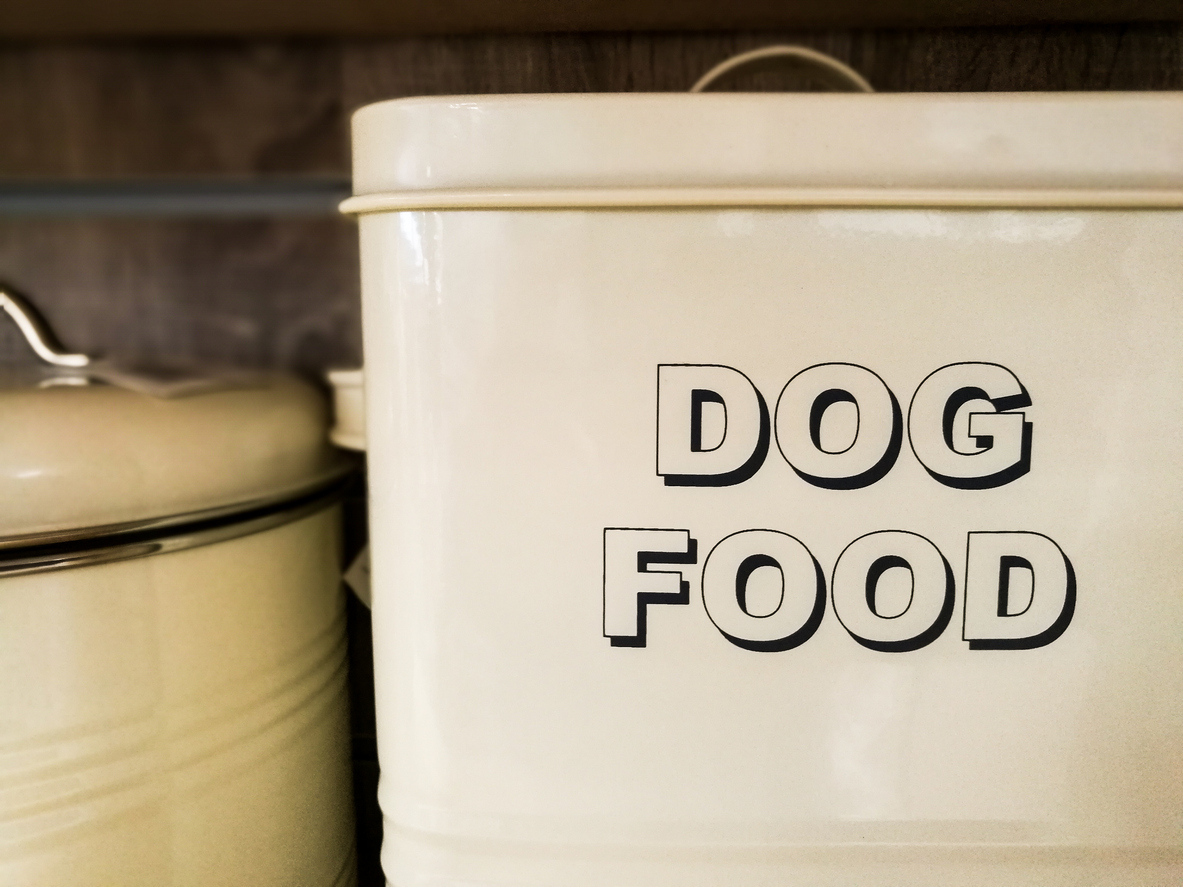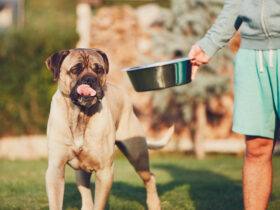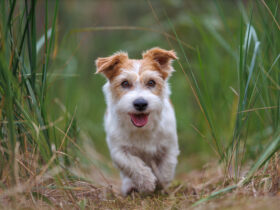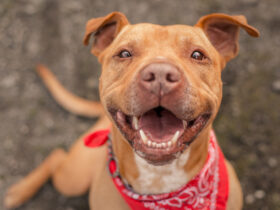Your dog’s food is the nutritional foundation for her health so we want to be sure it stays nutritious and tastes delicious for our best friends. It might not be the first thing we think about, but proper dog food storage is one way to keep your four-legged friend’s dining experience a happy one.
Fortunately, there are measures you can take to keep her food fresh and save you from wasting bags of kibble or wet food. We’ve compiled some best practices to help you properly store different types of dog food and treats.
How Much Dog Food Should I Buy?
Regardless of your choice of storage, one way to keep meals tasting fresh is to have the right amount of dog food on hand for your furry friend. Buying too much dog food at one time can mean that your dog will be eating that food for months and months. Buying too little dog food will lead to a hungry pooch and emergency trips to the pet store.
As a responsible pet owner, it’s important to determine how much your animal needs to eat. Dog food and treats can last a long time once made – as long as 12 to 24 months depending on the type of food.
As a general rule, you can use the following as a start to determine the dry dog food bag size you need:
- 4-6 pound bag = small dog, under 20 lbs
- 12-18 pound bag = medium dog, 20-50 lbs (or two small dogs)
- 24-30 pound bag = large dog, 50 lbs and over (or 2-3 medium dogs)
Using this suggestion, food will last about 5-8 weeks depending on the size of your dog and how much they eat. Keeping 1-2 months of food on hand helps to maintain the nutritional value and great taste.
How to Store Dry Dog Food
Even though it is so easy to handle, dry dog food does pose some storage challenges. Unlike most wet dog food, dry food isn’t readily available in single serving containers.
Exposure to air, moisture, and high temperatures can take their toll on dry dog food over time. Identifying the right storage solution not only protects your dry food from the elements, it can also help prevent your canine companion from sneaking a bag of treats or breaking into a whole bag of dog food for a midnight snack. As such, you’ll want to consider a few different factors for dry dog food storage.
Choose the right dry dog food storage container
Sealing food away in a resealable container allows you to keep your dog’s dry food as fresh as possible once you open a new bag. There are different lengths that you can go in terms of food storage. The simplest is to try and reseal the original bag.
Resealing the original bag.
A few bag clips are the quickest solution to dog food storage. Rolling or folding down the sides and closing them up is a relatively easy solution if you don’t have other storage methods. However, this method isn’t nearly as airtight as the following storage solutions.
Airtight tubs.
Arguably the best storage option is to invest in some plastic or stainless steel containers with resealable lids. You’ll want to buy a tub that will accommodate the size of dog food bags that you regularly buy. Some people opt to place the whole bag in these containers and just have an opening to scoop out the food. If you decide to pour your dog’s food in the container, make sure to keep part of that empty bag on hand to keep track of the feeding recommendations and any “best used by”/manufacturing dates for the product. Those date codes can be very helpful if you have any questions about the food.
Be sure that the container you are putting the food in is dry and clean before you empty the bag into it and that it has a snug lid. The tightfitting lid will not just keep your dog out, it will also help to keep out any bugs that are interested in the food as well. If you pour the food directly into the container, wash it each time you buy a new bag of food to keep it nice and clean and minimize any issues you might have.
Resealable bags.
If you don’t have any tubs or other solid containers, you can opt for some resealable bags. Of course, this route isn’t quite as helpful for bigger breeds who need more food – gallon bags will only go so far. Still, plastic bags with resealable tops are a cheaper, impromptu solution for your home or when you’re traveling with your furry friend.
Pick out a cool, dry, safe spot for your dog food containers
Once you have your preferred dog food storage containers, it’s time to figure out where you want to keep that container. A good container will do a great job of shielding your dog’s kibble from moisture and air, but it’s also important to find a good cool, dry spot to keep that container.
In general, dog food should not be exposed to warm temperatures for long periods of time. Warm, wet places can enable bacterial growth that will spoil your dog’s dinners. Even with a sealed container, heat, light, and moisture can potentially cause challenges. As such, try and store your dog food container somewhere that will stay cool and dry, preferably less than 80 degrees F.
How to Store Wet Dog Food
Unlike dry food, wet dog food is readily available in smaller containers. When purchased form the store, these containers are sealed tightly and have a “best by” date. With a proper seal, these dates can be months or years later. If you notice any notable dents, swelling, or air bubbles, that container’s seal may be compromised and should be avoided.
While wet dog food is sealed away from outside air and moisture, proper storage is still recommended. Each container is still vulnerable to heat and should be stored in the same cool, dry conditions as dry food.
What should I do with leftover wet dog food?
If there is still some wet dog food left in the container, it should last for a few days with proper storage. You’ll want to promptly refrigerate any unused portions of wet food or toppers to keep them safe for future use. Covering the food with a plastic lid, or putting it in an airtight container and squeezing out excess air will help protect the food and limit any aroma in your fridge. Check to see that your refrigerator is set to 40 degrees F or below.
In general, a properly refrigerated wet food should last for three to five days. If the food becomes watery, the aroma changes, or the texture is different, you may want to err on the side of caution and throw out that food.
How to Store Frozen Dog Food
As you may expect by the name, there’s a natural place to store frozen dog food: your freezer. This option allows you to thaw out these bags in your fridge so that you can feed your furry friend a fresh meal. Once a bag thaws, you should keep it refrigerated until mealtime and keep it in the refrigerator as long as it stays fresh.
As with dry dog food, you’ll want to buy the appropriate bag size for your dog. If it’s your dog’s primary food, a smaller dog means a smaller bag of food. If you are feeding it as a topper, the same rule applies. Larger dogs would need a bag that is 5 lbs. Note the instructions on your food for storage. For Bil-Jac Frozen, once thawed, it should be used within seven to 10 days. While it may be tempting to simply refreeze the food, that should be avoided for food safety reasons.
Storing Treats
Many dog treats are in convenient packages that can easily be closed and resealed until needed. Keeping your dog’s treats sealed up helps to keep them soft or crunchy, as well as tasty. When it comes to dog snacks, you’ll want to store them out of reach on a countertop or in a cabinet in a cool, dry place so your dog doesn’t help herself when you are not around.
Protecting Your Furry Friend One Meal at a Time
With proper storage, you can help ensure that your dog’s mealtime is an enjoyable experience. Want to learn more about how you can improve your best friend’s eating experience? Sign up for the Best Friends Club to receive our exclusive monthly email newsletter for more dog care advice, nutritional info, and special members-only discounts on Bil-Jac Dog Food, Treats, and other products.







Leave a Reply